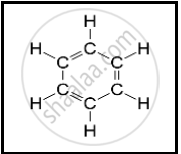Advertisements
Advertisements
प्रश्न
State one major difference between covalent and ionic bonds and give one example each of covalent and ionic compounds.
उत्तर
Covalent compounds have usually low melting points and boiling points. But ionic compounds have high melting points and boiling points.
An example for a covalent compound is methane (CH4).
An example for an ionic compound is sodium chloride (NaCl).
APPEARS IN
संबंधित प्रश्न
Why covalent compounds are different from ionic compounds?
State the reason to explain why covalent compounds "are bad conductors of electricity".
Choose the most appropriate answer from the following list of oxides which fit the description.
A covalent oxide of a metalloid.
Name the black substance of pencil. Will the current flow through the electrical circuit when we use the sharpened ends of the pencil to complete the circuit?
Name a carbon containing molecule which has two double bonds.
Why does carbon form compounds mainly by covalent bonding?
What is buckminsterfullerene?
Give two general properties of ionic compounds and two those of covalent compounds.
What is graphite?
The atomic numbers of four elements P, Q, R and S are 6, 10, 12 and 17 respectively. Which two elements can combine to form a covalent compound?
(a) P and R
(b) Q and S
(c) P and S
(d) R and S
A saturated hydrocarbon has fifty hydrogen atom in its molecule. The number of carbon atoms in its molecule will be
(a) twenty five
(b) twenty four
(c) twenty six
(d) twenty seven
You can buy solid air-freshners in shops. Do you think these substance are ionic or covalent? Why?
Define a covalent bond.
Draw an electron dot diagram for the formation of the following. State the type of bonding present in them.
Hydroxyl ion
The following structural formula belongs to which carbon compound?

The electronic configuration of N2 is 2, 5. How many electrons in the outer shell of a N atom are not involved in the formation of a nitrogen molecule?
Name two compounds that are covalent when taken pure but produce ions when dissolved in water.
Name the anion present in the following compound:
When a barium chloride solution is added to a solution of compound B, a white precipitate insoluble in dilute hydrochloric acid is formed.
State the reasons, why carbon cannot
- Lose four electrons to form C4+ cation and
- Gain four electrons to form C4- anion.
How does carbon overcome this problem to form compounds?
